
Did you know that Truthout is a nonprofit and independently funded by readers like you? If you value what we do, please support our work with a donation.
Red flags flutter from every building and lamppost, surrounded by a sea of giant cranes scarring the skyline. Wherever one looks, buildings are under rapid construction. Car showrooms full of gleaming Western luxury vehicles wait silently, ready to be driven off the forecourt by the small segment of newly affluent Vietnamese with tens of thousands of dollars in disposable income. Funded by Western and Japanese banks, ultra-modern airport terminals rise among the paddy fields, as urban expansion explodes across a countryside still dominated by small farmers tending six acre plots.
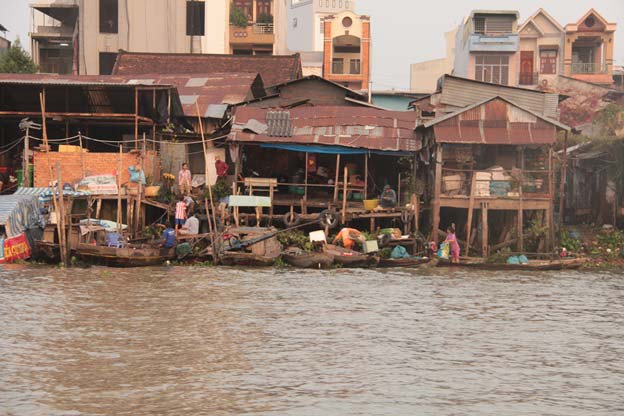 Residents of the southern city of Can Tho unload vegetables and fruit from an early morning floating market. (Credit: Chris Williams)
Residents of the southern city of Can Tho unload vegetables and fruit from an early morning floating market. (Credit: Chris Williams)
Emblazoned with the symbol of proletarian unity and emancipation, it’s clear that the worker’s hammer crossed with a peasant’s sickle, sown into the corner of each red flag, is a long way from the national guiding principle of the Vietnamese Communist Party, in a country which has strayed very far from Ho Chi Minh Thought.
Embalmed in his mausoleum since his death in 1969, Ho Chi Minh was very much a proponent of national development, though it seems unlikely that the much-venerated leader of the Vietnamese resistance to first French, then American rule, would recognize much of the program of the party he helped found in the 1920s.
By the 1980s, the Vietnamese Communist Party had begun the process of instituting a “socialist-oriented market economy.” Its policy of Doi Moi (“Renovation”) in 1986, the normalization of diplomatic relations with the United States in 1995, and the signing of a bilateral trade agreement in 2001 facilitated Vietnam joining the World Trade Organization in 2007. Through the instigation of market reforms and liberalization, the Communist Party has sought to overcome the problems of distribution and manufacture of goods and food production generated by a centralized, top-down, one-party state.
Vietnam is no stranger to external demands driving huge changes to the country, as the French embarked on a frenzy of canal building and irrigation works from the 1850s onwards until the Americans took over a century later, by draining, defoliating and dredging new areas, to more effectively prosecute the war they were destined to lose.
What is meant by “development?” What are the true costs and who really benefits? Furthermore, in the context of climate change, how long can this continue?
As none of this “development” was aimed at benefiting the majority of the local population, an economically, socially and ecologically devastated Vietnam periodically suffered famine and food shortages throughout the 1970s and early 1980s. Combined with the internal impetus to feed the population, came a new and even more powerful external force pressing for change: the seemingly unstoppable power of the market. Having seen what this has done to the country in the intervening two decades, once again in the history of Vietnam, the question arises: What is meant by “development?” What are the true costs and who really benefits? Furthermore, in the context of climate change, how long can this continue?
Vietnam, a country which already suffers from some of the largest numbers of extreme weather events due to its location and topography, is predicted to be one of the countries most severely impacted by climate change and extreme weather events, and ranks sixth on the Climate Risk Index. According to the World Bank:
Sea-level rise of 30 centimeters to one meter over the next 100 years is expected, which is projected to cause capital value loss every year of up to US$17 billion (80 percent of the country’s annual GDP) if no protective measures are taken. The increased risk is not restricted to coastal areas; in fact, rise of river beds and backwater effects will also cause serious problems to inland river regions, with a total of 40,000 km2 flooded annually.
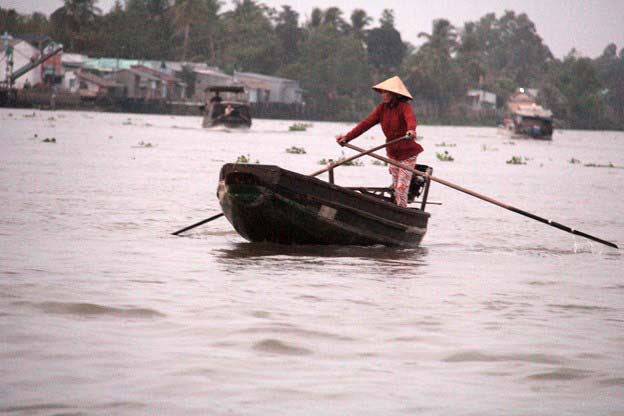 A woman rowing to work on the river Hau, southern Vietnam. (Credit: Chris Williams)
A woman rowing to work on the river Hau, southern Vietnam. (Credit: Chris Williams)
Recognized by the ruling elite as a necessity for the rebuilding of a war-ravaged and deeply impoverished country capable of competing on the world market, a process of rapid “modernization and industrialization” was adopted. Socialist rhetoric was retained and more statues to Uncle Ho built, even as inequality rose alongside the new buildings and exponential, market-driven increases in GDP.
As a result, for the last two decades, a high-octane growth rate of 5 to 7 percent has produced an economy that has doubled in size. Extreme poverty has declined significantly, allowing the country to officially reach the World Bank’s bracket of “lower middle income,” with a GDP per capita of $1,130 by 2011. The phenomenal rate of growth is predicted to continue, which accounts for the palpable evidence that Vietnam is very much “developing” before people’s eyes.
Completing the transition to an export-oriented economy determined to grow by the most extreme principles of laissez-faire, neoliberal nostrums, Vietnam is the poster child for the World Bank’s idea of what development should look like. Eager for more accolades from the world of international finance, determined to privatize its remaining state-owned enterprises and further liberalize the economy, the Communist Party leadership is proactively negotiating with the United States for the Socialist Republic of Vietnam’s involvement in the extremely controversial Trans Pacific Partnership, to seal its entry into the glowing world of neoliberal economic orthodoxy.
It’s no surprise, therefore, that the entrance of Vietnam into the current pantheon of Western banks’ list of praiseworthy nations has come to the attention of the wider investment and political community. High-level state visits multiply between the former combatants, new trade deals are struck, USAID and the US Commerce Department in Vietnam are kept busy searching for new opportunities to offer aid and sniff out commercial opportunities for US corporations to, as stated in the mission statement of USAID, “further US foreign policy goals.”
Under the cheerily unambiguous title “Where to Bet Now?” the January/February issue of the journal Foreign Affairs began its cover article with a paean to capitalist development in six emerging markets. The highlighted areas are described as increasingly “attractive to investors” due to the ongoing ramifications of the global financial crisis of 2008; former favorites among the BRICS are said to be “cooling.”
Put differently, the region contains the two components Marx highlighted as critical for capitalist exploitation, development and growth: labor and the earth.
One of the “newest and brightest stars” is Vietnam, specifically the Mekong Delta in the southern half of the country, as “diverse economies take advantage of their ancient cultural ties and new transportation links to grow together.” The segment on the Mekong region, which encompasses Yunnan Province in China, Myanmar, Thailand, Cambodia, Laos and southern Vietnam, according to Thitinan Pongsudhirak, director of the Institute of Security and International Studies at Chulalalong University in Bangkok, can barely contain its breathless excitement for the possibilities of growth and profit.
Pongsudhirak documents how the region boasts the perfect combination of large, “young, working-age populations” on low wages, ripe for roping into globalized capitalism and “an abundance of natural resources, from land suitable for agriculture and timber to vast mineral deposits and considerable oil and gas reserves.” Put differently, the region contains the two components Marx highlighted as critical for capitalist exploitation, development and growth: labor and the earth.
In the vision of Pongsudhirak, this will result in “a new era of promise and prosperity,” with the pace of future growth in Vietnam set to maintain the same breakneck pace of more than 7 percent per year. The Mekong River is the 12th longest in the world, with a length and surrounding area equivalent to more than a quarter the size of the United States, and the region is lauded as the perfect setting for your loose investment dollars, set for a bright future of development, jobs and economic growth.
Except, on the ground, for the majority of the more than 60 million people in Cambodia, Laos and Vietnam who nourish themselves and their culture from the life-sustaining waters of the Mekong, its fish and agriculture, the future looks decidedly different. Water cascading down from the high mountain plateau of the Himalayas and gushing throughout the country in an astonishing array of rivers and delta systems, fed by the annual monsoons, accounts for the spectacular levels of biodiversity, richness of soil and of culture.
The dams will radically alter the giant seasonal flows of water and sediment, as well as making insurmountable barriers for the more than 850 species of fish, nearly 200 of which are migratory over long distances.
“One can find water in every corner of the music here,” said Le Dinh Bich, “just as one can find the sound of horses throughout the rhythms of the Middle East.” For Bich, a musician, author, educator and renowned cultural scholar of the Mekong Delta, changes to regional ecology cause cultural changes: if one interferes with the flows of the river, as breakneck economic development and hydroelectric projects along the Mekong are threatening to do, one interferes not only with a biological, but also a cultural ecosystem, which have co-evolved over thousands of years. Water is everywhere in the Mekong, and people’s lives revolve around its cadence of dry and wet seasons, the inundations that are the source of life and rejuvenation – and also carry the potential for destruction.
The mighty Mekong, pouring more than 380 million acre-feet of water annually into the South China Sea, along with 160 million tons of sediment required to fertilize and nourish the surrounding land, fish and people, is threatened by dam building at one end and sea-level rise at the other. These twin threats, both a result of capitalist development, are threatening the integrity of the last great river to remain substantially unmodified by human economic activity.
With plans for a dramatic increase in large dams upstream, particularly in Laos, which hopes to become “the battery of [Southeast] Asia” to fuel the burgeoning, energy-thirsty economies of the region, all is set to change. On the drawing board are plans for 14 large dams and dozens of others able to generate 14,000 megawatts of power and boost the energy production of Southeast Asia by 25 percent along the length of the Mekong, as the river drops 5,000 meters from the mountains to the sea. Though it has been the subject of intense local protests and contravenes the intergovernmental Mekong River Commission’s recommendations, the Xayaburi dam in Laos is already under construction.
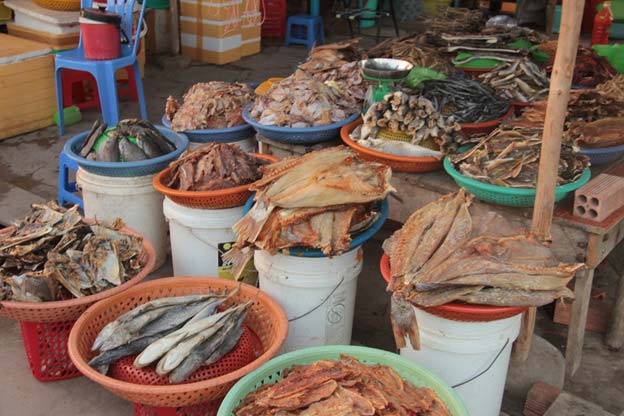 Abundant fish in a market in a town market in the Mekong. (Credit: Chris Williams)
Abundant fish in a market in a town market in the Mekong. (Credit: Chris Williams)
Warfare, geography and Great Power politics have kept the Mekong largely inaccessible to the kind of giant mega projects that have reshaped much of the rest of the world’s rivers in the latter half of the 20th century – and limited road and rail building that might have facilitated them. The Mekong runs wild and free for the majority of its length, from the icy mountains high in the Tibetan Himalayas on its 2,800-mile journey down to the humid tropics of southern Vietnam.
The dams will radically alter the giant seasonal flows of water and sediment, as well as making insurmountable barriers for the more than 850 species of fish, nearly 200 of which are migratory over long distances. As 90 percent of the protein intake of Cambodians comes from fish in a region that has the highest per capita intake of fish in the world (up to 50 kilograms per person per year), and the Mekong is the primary fish and agricultural producer of Vietnam, the dams pose an existential threat to the people of the entire region.
Increasing rice production, via a technology-driven Green Revolution, dam building and the institution of Doi Moi, which disbanded collective farms and made other market reforms, have now made Vietnam the second largest rice exporter in the world. The Mekong Delta is home to 20 percent of the population of Vietnam, but contributes 50 percent of its agricultural products: 50 percent of all rice, 60 percent of fruits and 65 percent of aquaculture.
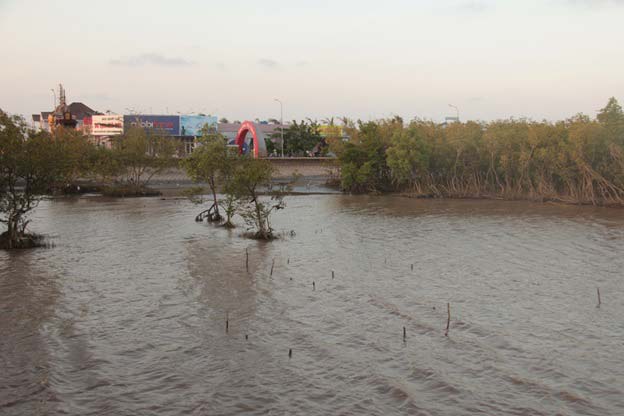 (Credit: Chris Williams)
(Credit: Chris Williams)
But food security has come at a heavy price, as the Mekong Delta, the food basket of the country, has lost 90 percent of its natural wetlands due to government projects to encourage people to move to coastal areas, clear the mangroves and start rice, fish and shrimp farming on a much more intensive scale. To further aggravate the problem, and make it potentially insuperable, it’s not economic development only that threatens the integrity of a way of life based around the Mekong’s water flows, and the staggering biodiversity and fecundity of life that the river nurtures as it throbs to the beat of the monsoons.
Another, longer-lasting aspect of capitalist development, climate change, is altering rainfall patterns by making the rainy season shorter but more intense, elongating the dry season and increasing the unpredictability of rainfall and the number of hot days. Rising sea levels, the extensive removal of mangrove and government-encouraged increases in coastal population, resettlement and development, which is depleting aquifers, are all contributing factors leading to salt water intrusion along the coast.
Not only does this create land subsidence, so exacerbating sea-level rise, but because rice requires fresh water, it makes it impossible to farm the staple crop of the country, leading to conflict between rice and shrimp farmers over land and water. Climate change is thereby acting to intensify the changes wrought by a Vietnamese economy driven at whirlwind pace by the principles of neoliberal growth, as the two ingredients intertwine and feedback on one another to threaten the long-term viability of the whole region.
Climate change is thereby acting to intensify the changes wrought by a Vietnamese economy driven at whirlwind pace by the principles of neoliberal growth, as the two ingredients intertwine and feedback on one another to threaten the long-term viability of the whole region.
Though they have done nothing substantive to reorient their economies to achieve this goal, world leaders have officially committed themselves to ensuring that the planet stays below two degrees Celsius of average warming. However, even if the world were on track to achieve that objective – which we are not – it obscures the fact that some regions, and the people who live in them, will pay a heavy and disproportionate price that could render their lives and cultures impossible to sustain. Vietnam, particularly the Mekong Delta, already on the path of typhoons, and much of which has an average elevation above sea level of only 1.5 meters, but where 20 million people live, is recognized as just such a region.
These broader changes are compounded by an intensification of agricultural practices and hydropower development. Rice production has increased to such a degree that Vietnam has moved from a country that had to import rice to feed its population in the 1980s to become the world’s second largest exporter today. The move to plant more rice acreage has been accompanied by changes to the variety of rice which will grow faster, but require irrigation, fertilizer and pesticide use so that crops can be harvested three times, rather than once or twice per year.
The over-reliance on high-yield, fast-growing rice, growing over larger areas, not only exposes rice crops to more serious pest and disease problems, but also threatens the resilience of a co-evolved, socio-biological rice culture in Laos, where there are more than 13,000 recognized varieties of rice, each with distinct names and properties. As USAID’s 2013 report on Mekong Adaptation and Resilience to Climate Change reports, “From a systems perspective, the higher vulnerability of commercial farming systems is more clear-cut . . . Subsistence systems tend to be more complex and a failure in one component can be substituted by another.”
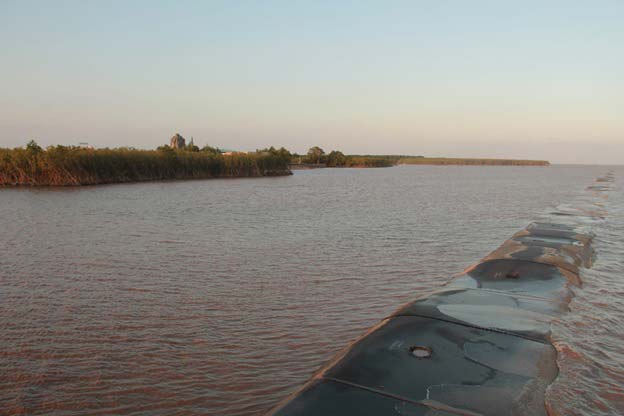 Laying a chain of giant, sand-filled rubber pontoons, in a last desperate and expensive attempt to prevent further coastal erosion. (Credit: Chris Williams)
Laying a chain of giant, sand-filled rubber pontoons, in a last desperate and expensive attempt to prevent further coastal erosion. (Credit: Chris Williams)
Shrimp farming, though more precarious and shorter term, earns far more than rice, bringing an inevitable shift to intensive shrimp farming and aquaculture for export – worth 4 percent of the country’s GDP and making Vietnam third in the world in shrimp exports. Coastal shrimp farming has led to a massive removal of mangrove, which in turn has encouraged saltwater intrusion, coastal erosion and reductions in wild fish populations.
The area for shrimp farming increased from 90,000 hectares in 1991 to 460,000 hectares in 2003; by 2011, this had reached 640,000 hectares, with a government production target of 1.2 million hectares by 2020. Alongside the expansion of shrimp farming, mangrove cover in the Mekong Delta declined from 208,000 hectares in 1990, to 83,000 by 1995, with further declines since. Reduction in natural wetlands, which are required for flood control, water purification, biodiversity and aquifer recharge, is estimated to be upwards of 80 percent. Intensive shrimp farming requires constant inputs of feed and pesticides, which, along with the waste from the shrimp, pollute the land so heavily that after three to five years it becomes highly degraded and unusable.
The over exploitation of resources, such as timber for the export of furniture, is increasing the impact of floods downstream of deforestation, which has left only 20 percent of forests untouched, as well as threatening the extinction of many indigenous species. An almost complete lack of waste treatment facilities, a relatively high population density and growing urbanization are all further exacerbating an unsustainable growth paradigm, as rivers become increasingly contaminated from industrial, agricultural and domestic waste streams.
Coastal shrimp farming has led to a massive removal of mangrove, which in turn has encouraged saltwater intrusion, coastal erosion and reductions in wild fish populations.
Whereas the US government produces excellent 800-page national climate change assessments on the current measured, observed and significant negative impact of climate change on different regions of the United States, the president and media then combine to ignore the issue. In contrast, on a daily basis in Vietnam, climate change and environmental issues are often a feature of the more than 70 government-controlled newspapers, with regular reports in the English-language Vietnam News.
In 2012, the government approved the “National Green Growth Strategy for the period 2011-2020, with a vision for 2050,” which highlighted the need for “sustainable development.” The move to a low carbon economy was put forward as one part of the National Climate Change Strategy, whereby “Green growth is the cause of the entire Party, all people, every level of Government, ministries, localities, enterprises, and social organizations.”
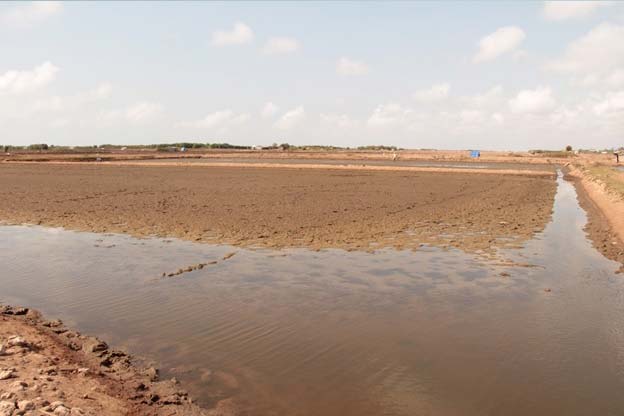 Intensive shrimp farming, where profit must be accumulated quickly, leaves the land devastated and barren within a few short years. (Credit: Chris Williams)
Intensive shrimp farming, where profit must be accumulated quickly, leaves the land devastated and barren within a few short years. (Credit: Chris Williams)
Yet, while there are verbal and written assurances in government reports that development will be carried out sustainably and take into account climate change and the building of resilience, all while simultaneously seeking to reverse the growing income differentials in Vietnam – particularly those between small and large farmers and rural and urban populations – the reality is highly divergent. As the state has become more and more decentralized, what emerges from one government ministry often contradicts the plans coming from another, which often contradict what gets implemented at the municipal and regional levels of government.
As the state has become more and more decentralized, what emerges from one government ministry often contradicts the plans coming from another, which often contradict what gets implemented at the municipal and regional levels of government.
For example, though there are small developments in solar and wind power, renewable energy is predicted to be only 4 percent of energy generation, of a total energy demand that is set to double between 2010 and 2020. The percentage of fossil fuels for primary energy production is predicted to rise from 42 percent in 2002 to 69 percent of a much larger total by 2030. In practice, therefore, the Vietnamese government seems far more concerned with maintaining economic growth fueled by abundant oil, coal and gas reserves than it does with longer-term impacts on declining air quality in Hanoi and Ho Chi Minh City, or the fact that large parts of those cities could be regularly underwater by 2050.
The impact of government policies directed toward profit maximization, industrialization and modernization of all commercial, industrial and agricultural sectors and continued export growth, dictate an emphasis on short-term expansion rather than on longer-term planning, equity and sustainability.
The small projects and sums of money devoted to alternative energy supply, pollution control, sustainable agricultural practices and waste management – despite the valiant attempts of some Vietnamese scientists, agronomists and environmentalists – indicate that on the current path, the ruling elite of Vietnam are loading the dice toward greater and greater instability and vulnerability, as climate change and capitalism combine to undermine the needs and long-term viability of the astonishing biodiversity of the Mekong and its surrounding vibrant and ancient river culture.
As Professor Le Anh Tuan of the College of Environment and Natural Resources Research Institute for Climate Change at Can Tho University remarked, the people of the Mekong River Delta have gone from “living together with floods” to “living together with climate change.” The question begs: can they live together with the increasingly destructive capacities of both capitalism and climate change?
Press freedom is under attack
As Trump cracks down on political speech, independent media is increasingly necessary.
Truthout produces reporting you won’t see in the mainstream: journalism from the frontlines of global conflict, interviews with grassroots movement leaders, high-quality legal analysis and more.
Our work is possible thanks to reader support. Help Truthout catalyze change and social justice — make a tax-deductible monthly or one-time donation today.